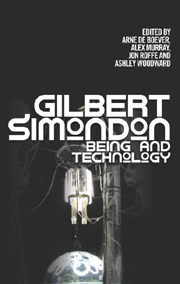Book contents
- Frontmatter
- Contents
- Abbreviations
- Editors' Introduction: Simondon, Finally
- 1 Technical Mentality
- Explications
- Implications
- Resonances
- 9 Gilles Deleuze, a Reader of Gilbert Simondon
- 10 Science and Ontology: From Merleau-Ponty's ‘Reduction’ to Simondon's ‘Transduction’
- 11 The Question of the Individual in Georges Canguilhem and Gilbert Simondon
- 12 The Theatre of Individuation: Phase-Shift and Resolution in Simondon and Heidegger
- Glossary: Fifty Key Terms in the Works of Gilbert Simondon
- Notes on Contributors
- Index
11 - The Question of the Individual in Georges Canguilhem and Gilbert Simondon
from Resonances
Published online by Cambridge University Press: 12 September 2012
- Frontmatter
- Contents
- Abbreviations
- Editors' Introduction: Simondon, Finally
- 1 Technical Mentality
- Explications
- Implications
- Resonances
- 9 Gilles Deleuze, a Reader of Gilbert Simondon
- 10 Science and Ontology: From Merleau-Ponty's ‘Reduction’ to Simondon's ‘Transduction’
- 11 The Question of the Individual in Georges Canguilhem and Gilbert Simondon
- 12 The Theatre of Individuation: Phase-Shift and Resolution in Simondon and Heidegger
- Glossary: Fifty Key Terms in the Works of Gilbert Simondon
- Notes on Contributors
- Index
Summary
Is the individual a reality? An illusion? An ideal? There is no single science, not even biology, that can answer this question. And if all sciences can and must contribute to the answer, it is doubtful that the problem is properly scientific, in the sense in which this word is commonly used.
These are the questions and considerations that Georges Canguilhem associates in 1945 with the problem of biological individuality – posed, according to him, by the concept of the cell. From his medical thesis on Quelques problèmes concernant le normal et le pathologique (1943) [Some Problems Concerning the Normal and the Pathological] until his last lectures at the Collège Philosophique in 1947, one can see an ambitious philosophical programme establish itself whose spirit can be summed up in a striking formula: ‘The problem of individuality is itself indivisible.’
The essential part of Canguilhem's œuvre is not so much the successful execution of this initial programme. It is, rather, this programme's dismantling, and then, as if by surprise, its reconstitution through the transfer of concepts. It is from this singular trajectory that it drew – and still maintains – its exceptional force of intellectual solicitation. This essay will discuss Canguilhem's work, focusing on its relation to the work of one of Canguilhem's students, Gilbert Simondon.
In the life sciences where he chose to establish himself, Canguilhem was in the same situation as Gaston Bachelard in physics in the 1920s: because of an unexpected leap of scientific progress, he was forced to ‘reeducate himself several times’.
- Type
- Chapter
- Information
- Gilbert SimondonBeing and Technology, pp. 176 - 184Publisher: Edinburgh University PressPrint publication year: 2012



